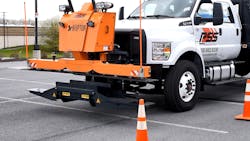Pennsylvania Turnpike reviews rumble strip handling machine
Traffic engineers at the Pennsylvania Turnpike Commission (PTC) first tested RoadQuake 2F Temporary Portable Rumble Strips (TPRS) in live work zones in September and October of 2015. Their goal was to determine if TPRS arrays would increase driver awareness and alertness in their work zones.
Staff from Gibson-Thomas Engineering recorded speed and noise measurements within an active work zone for two nights on I-476 near Quakertown, Pa. Gibson-Thomas Engineering also observed driver behavior in advance of the lane merge transition to determine at what distance from the start of the lane transition drivers decided to merge.
Gibson-Thomas Engineering compiled the results into a report for PTC, entitled “RoadQuake Temporary Portable Rumble Strip Pilot Project, Summary of Findings” in May 2016, a summary of which is here.
Gibson-Thomas Engineering reported that drivers, once alerted by arrays of TPRS, merged 650-750 ft in advance of the merge transition, a 400-ft increase over traditional work-zone signage, and a 100-ft increase over Pennsylvania State Police Troopers stationed in the work zone. The study indicated that TPRS increase driver awareness in work zones. Although the RoadQuake TPRS were designed with the intent to alert distracted drivers to non-typical roadway conditions, the report also indicated that TPRS arrays on average reduced drivers’ speeds in a work zone by 8%. While alerting distracted drivers of an approaching work zone is the primary benefit of RoadQuake TPRS, several studies indicate drivers reduce speed in work zones when TPRS arrays are deployed as a secondary benefit.
The report concluded: "Further implementation of the RoadQuake temporary portable rumble strip system or PSP presence entering a work zone should be considered as tools to improve work zone safety. Given the comparable results of both the rumble strips and PSP presence, further consideration should be given to the implementation of the RoadQuake system.”
Although the 2016 report indicated that TPRS arrays alert distracted drivers and increase driver awareness in work zones, PTC traffic engineers asked PSS to solve a complementary issue: how to keep PTC maintenance and construction workers safer in work zones when deploying TPRS arrays? PTC makes every effort to keep their workers safe in work zones when working next to active traffic. Having workers get out of their vehicle to install or remove TPRS arrays is counterproductive.
While PSS had developed several handling equipment devices in 2015–2017, all of which reduced worker exposure to live traffic, workers still had to deploy TPRS arrays by hand. By early 2018, with the introduction of the RAPTOR Rumble Strip Handling Machine, the worker exposure issue had been solved. Mounting to the front of a vehicle, much like a snow plow, RAPTOR transports, deploys, realigns and retrieves RoadQuake 2F TPRS without exposing workers to active traffic. The vehicle driver operates RAPTOR from the safety of the vehicle cab.
Pennsylvania Turnpike traffic engineers observed a RAPTOR demonstration at a trade show this past January. Arrangements were then made for a demonstration at PTC facilities in Harrisburg, Pa., for additional PTC staff to observe the RAPTOR and its functions in person. The demonstration was conducted on April 18 in the parking lot of the PTC Traffic Operations Center. Approximately 30 people attended the presentation and demonstration including representatives of Pennsylvania DOT, Delaware DOT, FHWA and the Pennsylvania State Police.
In the parking lot, PSS demonstrated how RAPTOR safely deploys and retrieves rumble strips. From the safety of the cab, the vehicle driver deployed three strips, and backing up, retrieved them. RAPTOR deploys a set of three strips in under 90 seconds and retrieves three strips in under 2.5 minutes. RAPTOR also realigned a strip that was intentionally skewed to demonstrate a possible situation that could occur in live traffic.
PSS then demonstrated RAPTOR’s main operational functions from outside the vehicle, using the remote control to show deployment and retrieval motions. Attendees also sat inside the vehicle to watch the driver perform various functions with the on-board camera monitor and remote control.
After the demo, PTC traffic engineers concurred that RAPTOR reduces workers’ exposure to live traffic when installing TPRS by keeping the worker inside of their vehicle. Furthermore, with RAPTOR, TPRS users can now deploy rumble strips in short-duration and mobile operations. And with a TMA-equipped vehicle, RAPTOR provides Portable Positive Protection for workers.
PTC traffic engineers requested a field test of RAPTOR in a live work zone. The field test is scheduled to be conducted in late June. PTC will also host a demonstration of RoadQuake 2F TPRS and RAPTOR Rumble Strip Handling Machine at IBTTA Maintenance & Roadway Operations Workshop, as part of the technical tour on June 24, 2018. PTC is a co-organizer of the IBTTA workshop.
-----------
Images courtesy of Garth Hess, Jr., Pennsylvania Turnpike Commission
